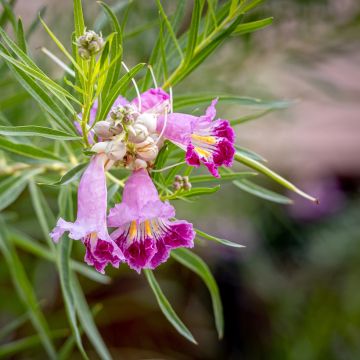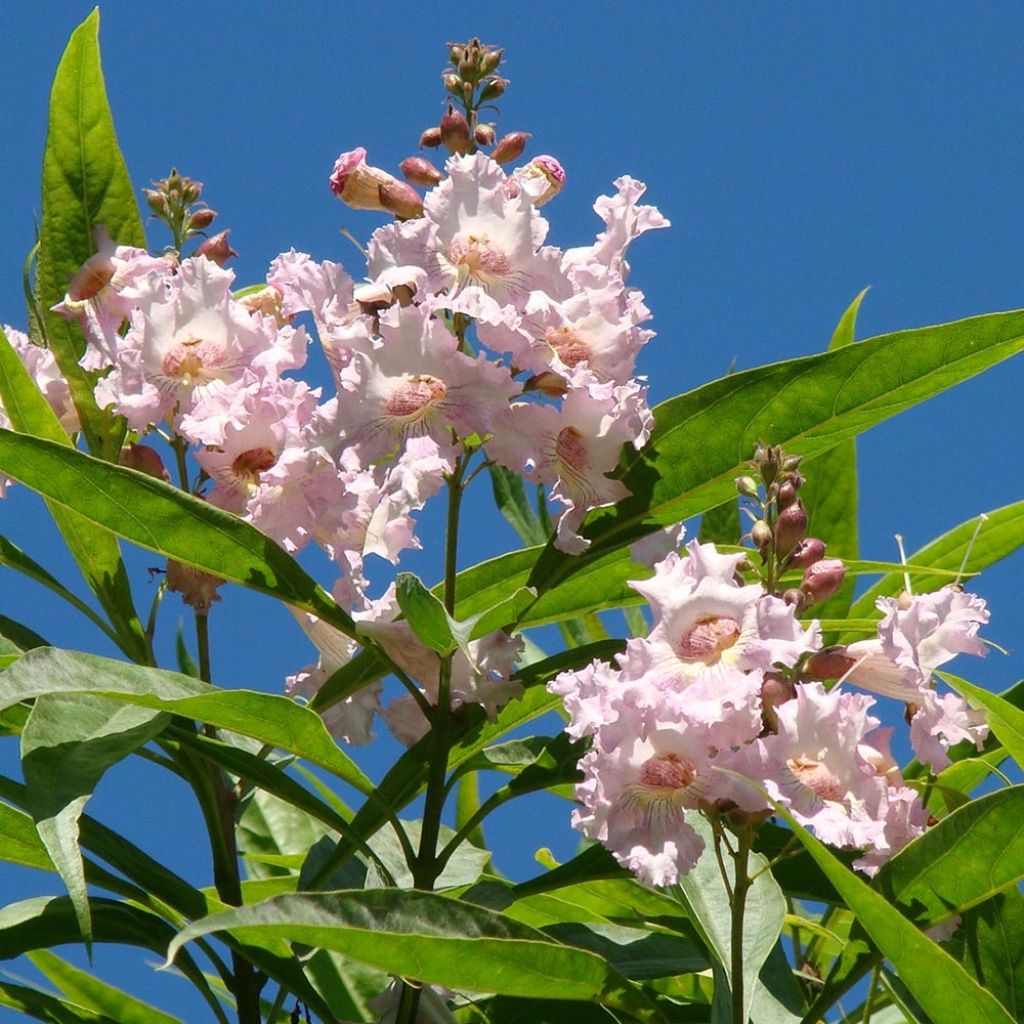

x Chitalpa tashkentensis Summer Bells
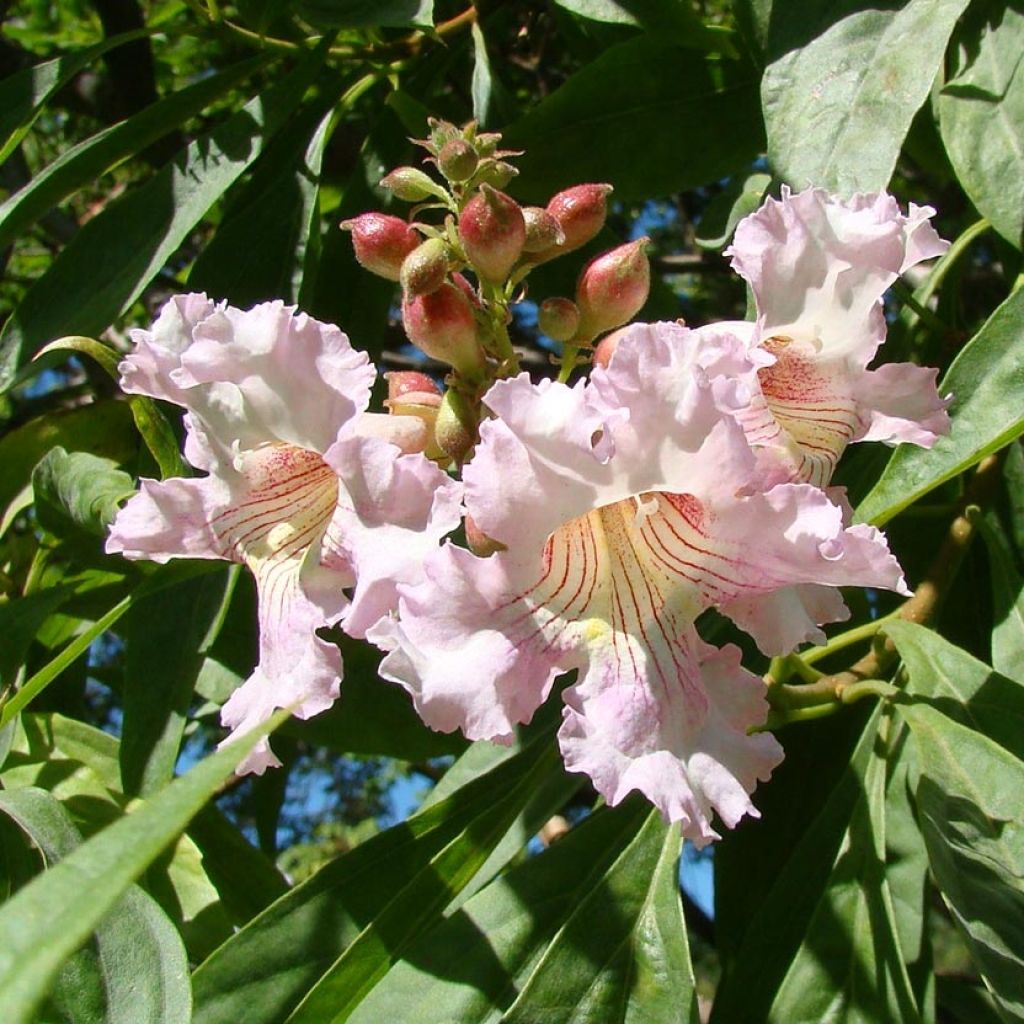

x Chitalpa tashkentensis Summer Bells
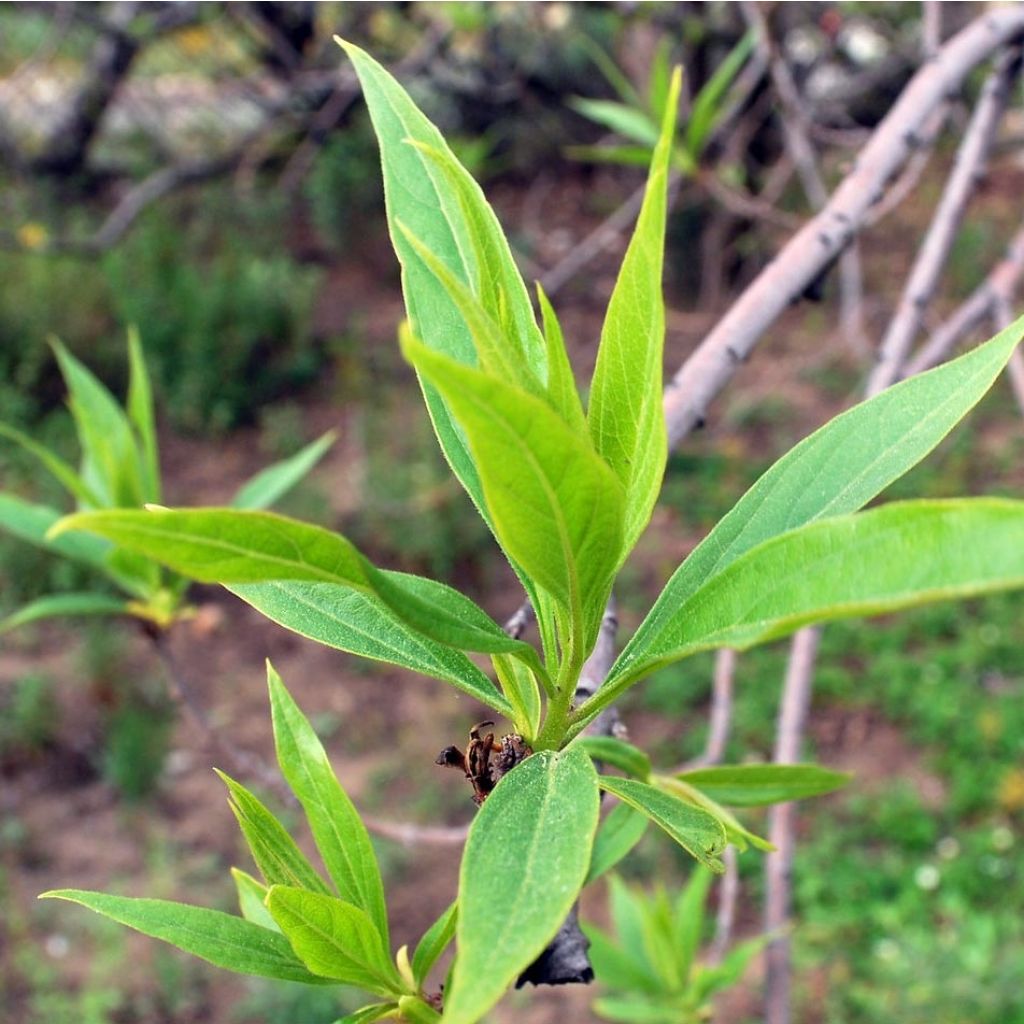

x Chitalpa tashkentensis Summer Bells
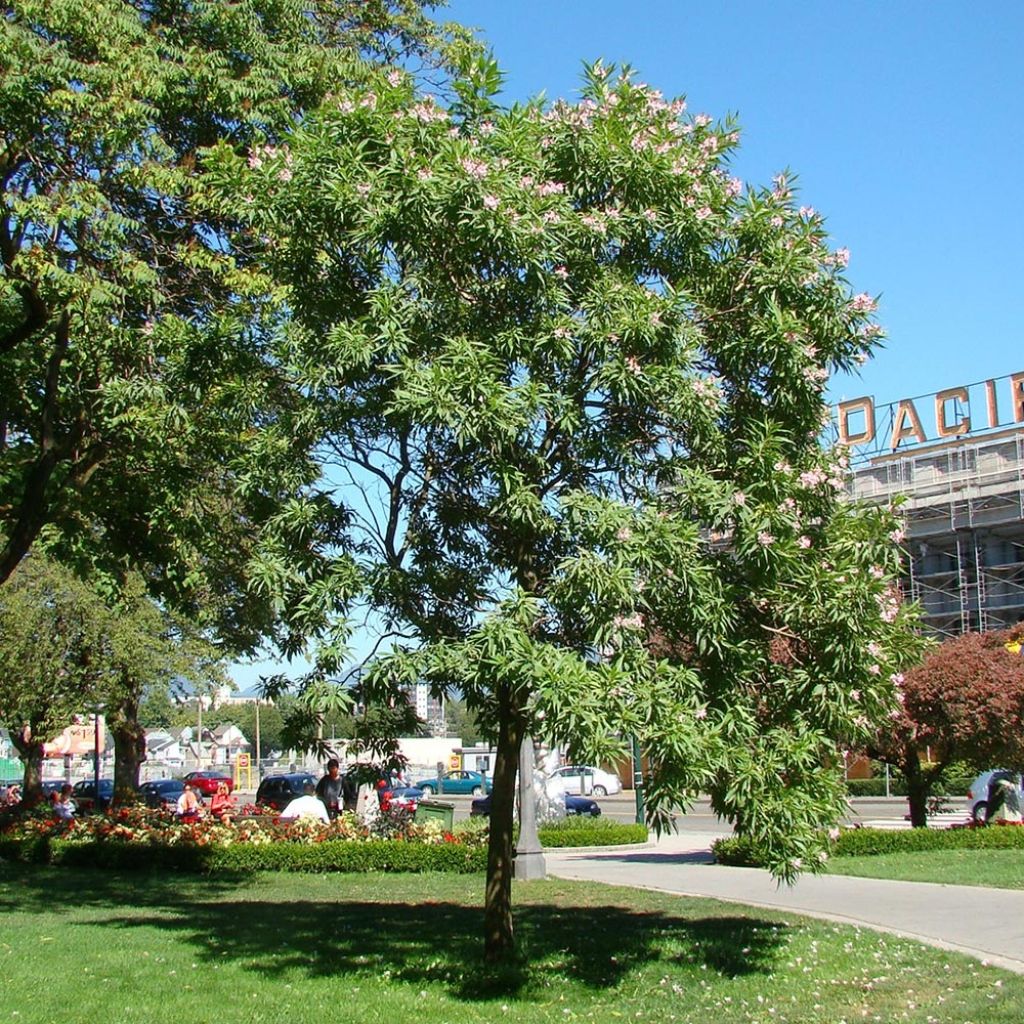

x Chitalpa tashkentensis Summer Bells
x Chitalpa tashkentensis Summer Bells
Chitalpa tashkentensis Summer Bells (Minsum)
Chitalpa, Tashkent Chitalpa
The roots are bare: there is not enough soil, the roots are overflowing from the pot. I hope the plant will recover.
THI, 11/01/2025
This item cannot be shipped to the selected country
Delivery charge from €5.90
Delivery to Corse prohibited
More information
Schedule delivery date,
and select date in basket
This plant carries a 24 months recovery warranty
More information
We guarantee the quality of our plants for a full growing cycle, and will replace at our expense any plant that fails to recover under normal climatic and planting conditions.
From €5.90 for pickup delivery and €6.90 for home delivery
Express home delivery from €8.90.
Delivery to Corse prohibited: UE law prohibits the import of this plant from mainland France to Corse as part of the fight against Xylella fastidiosa. Please accept our sincere apologies.
More information

Does this plant fit my garden?
Set up your Plantfit profile →
Description
x Chitalpa tashkentensis Summer Bells (Minsum) is a more compact version of the Chitalpa from Tashkent, more suitable for small gardens or container cultivation. It is a beautiful bush or small tree that combines summer flowering with exotic charm and is easy to grow in many regions. It is adorned with beautiful clusters of fragrant, nectar-rich, frilly trumpet-shaped flowers in pink-mauve with a pale yellow throat washed with white and streaked with purple. This hybrid variety also has a gentle countryside charm that is hard to resist. It deserves a special place in the garden, in the sun, in ordinary but well-drained soil.
Chitalpa tashkentensis is a hybrid obtained by spontaneous cross-breeding of Chilopsis linearis (desert willow) with Catalpa bignonioides (common catalpa). It was discovered in the Tashkent province in Uzbekistan, then multiplied "in vitro" in the 1960s. This large sterile bush belongs to the Bignoniaceae family. It perfectly withstands both cold (down to -20°C) and dry summers. The Chitalpa tolerates limestone well and likes deep, well-drained soil. The Summer Bells cultivar was selected by Minier Nurseries for its small size. It tolerates severe pruning in late winter without affecting its flowering. It won the 1st Prize at the Innovert Competition in Angers in 1999.
Left to grow freely, Chitalpa Summer Bells forms a small tree about 4 to 5 m in all directions, but regular pruning easily keeps it at 3 m high. It is bushy, branching, dense and rounded. It has a fairly short trunk, with low and drooping branches. Its grey bark is covered with light lenticels and cracks with age. Flowering occurs from late spring to summer (from May to August depending on the climate) with a possible second bloom in September. The flowers are grouped in conical and erect racemes, at the end of the branches. The wide flowers, about 3 cm in diameter, are tubular and bell-shaped, composed of 5 lobes, three of which are wider at the base and two smaller ones with wavy margins at the top. They are pale pink, tinged with mauve, revealing a throat streaked with pale yellow and purple. This flowering is visited by bees and butterflies and exhales a sweet and heady scent up close. This bush has deciduous foliage, which buds late in spring and falls in October-November. The leaves are a dark olive-green, sometimes speckled with purple in autumn. They are simple, 10 to 20 cm long, alternately arranged on the branches, narrow lanceolate, clearly veined on the underside, and carried by very flexible green stems. The wood of the Chitalpa is very light. This bush can be pruned close to the base, as it regrows from the crown.
X Chitalpa tashkentensis Summer Bells, with its pastel flowering surrounded by a gentle exotic fragrance, also has the simplicity of hedge bushes. Once well established, it is drought-tolerant and is a valuable asset for the garden in summer, flowering with buddleias, mock oranges, and of course roses. It can be planted as a standalone specimen, on the edge of a grove, in front of taller trees, trained as a climber, or as an informal hedge mixed with other species (flowering apple trees, Japanese cherry trees, Chinese almond trees, Japanese quinces, deutzias...).
Report an error about the product description
x Chitalpa tashkentensis Summer Bells in pictures
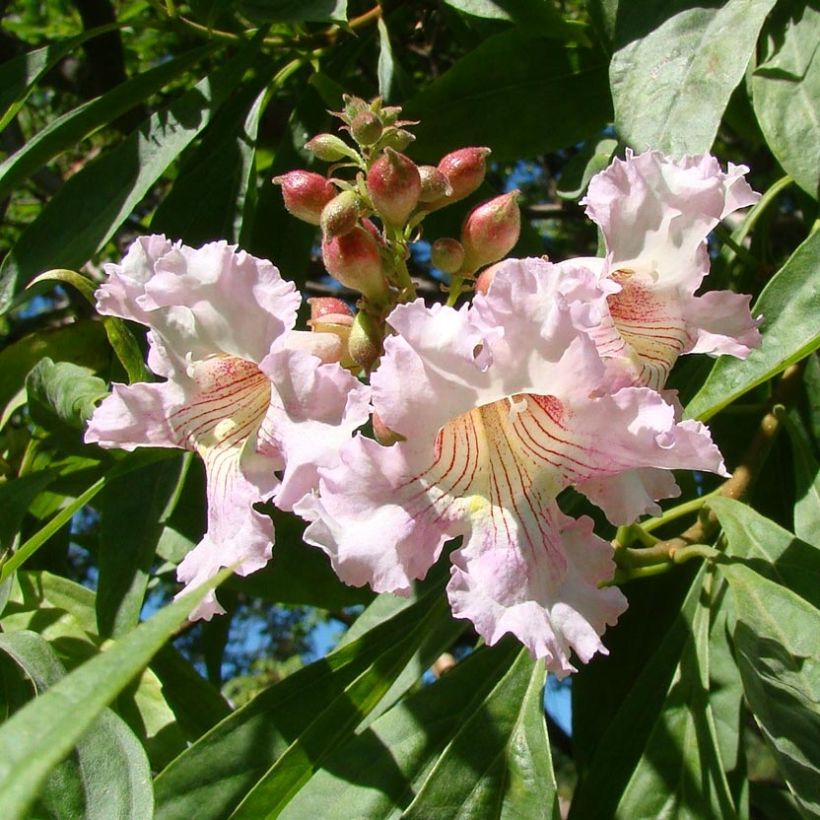

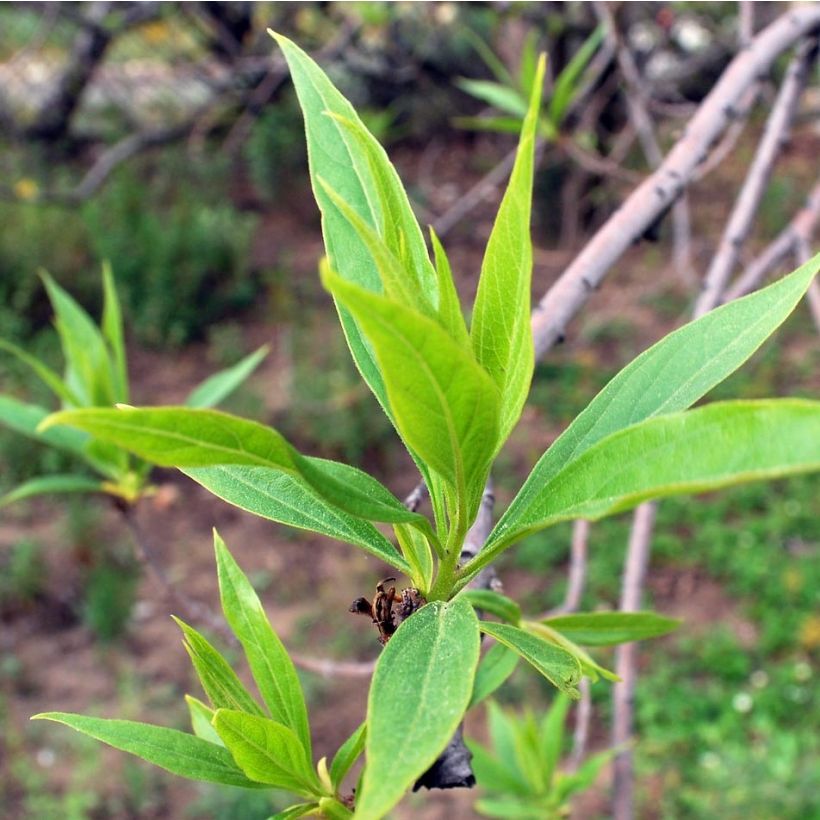

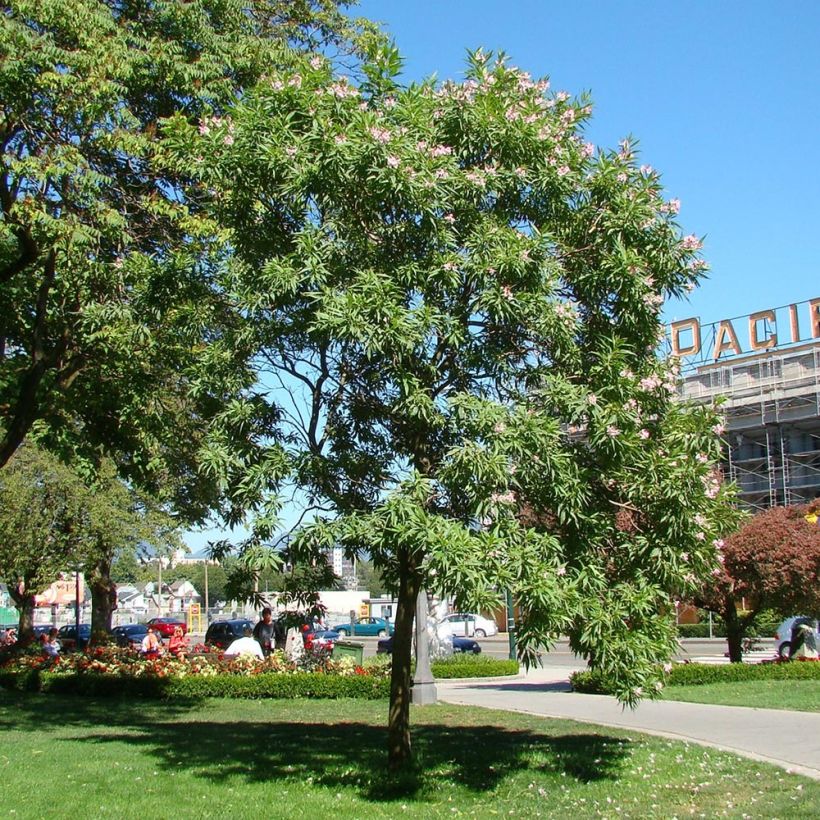

Plant habit
Flowering
Foliage
Botanical data
Chitalpa
tashkentensis
Summer Bells (Minsum)
Bignognaceae
Chitalpa, Tashkent Chitalpa
Cultivar or hybrid
Other Chitalpa and Chilopsis
Planting and care
Chitalpa tashkentensis Summer Bells should be planted from March to May (in cold regions) or from September to November, depending on the climate. It can tolerate any ordinary soil, but it prefers well-drained, loose, deep, even chalky soil. It is a good idea to provide a complete fertiliser every year at the beginning of the growing season. The substrate should be kept moist during the first few years of cultivation, and then this small tree can do without watering in summer, even in hot and dry climates. It is best to plant it in full sun (or in light shade in hot climates), as its flowering is better when it receives maximum light. Light pruning may be necessary for training purposes (for standard or tree form) in winter. To achieve a very bushy specimen, it is fine to prune it short at the end of winter without affecting flowering. The vegetation of this bush restarts late, in May.
Planting period
Intended location
Care
-
, onOrder confirmed
Reply from on Promesse de fleurs
Haven't found what you were looking for?
Hardiness is the lowest winter temperature a plant can endure without suffering serious damage or even dying. However, hardiness is affected by location (a sheltered area, such as a patio), protection (winter cover) and soil type (hardiness is improved by well-drained soil).

Photo Sharing Terms & Conditions
In order to encourage gardeners to interact and share their experiences, Promesse de fleurs offers various media enabling content to be uploaded onto its Site - in particular via the ‘Photo sharing’ module.
The User agrees to refrain from:
- Posting any content that is illegal, prejudicial, insulting, racist, inciteful to hatred, revisionist, contrary to public decency, that infringes on privacy or on the privacy rights of third parties, in particular the publicity rights of persons and goods, intellectual property rights, or the right to privacy.
- Submitting content on behalf of a third party;
- Impersonate the identity of a third party and/or publish any personal information about a third party;
In general, the User undertakes to refrain from any unethical behaviour.
All Content (in particular text, comments, files, images, photos, videos, creative works, etc.), which may be subject to property or intellectual property rights, image or other private rights, shall remain the property of the User, subject to the limited rights granted by the terms of the licence granted by Promesse de fleurs as stated below. Users are at liberty to publish or not to publish such Content on the Site, notably via the ‘Photo Sharing’ facility, and accept that this Content shall be made public and freely accessible, notably on the Internet.
Users further acknowledge, undertake to have ,and guarantee that they hold all necessary rights and permissions to publish such material on the Site, in particular with regard to the legislation in force pertaining to any privacy, property, intellectual property, image, or contractual rights, or rights of any other nature. By publishing such Content on the Site, Users acknowledge accepting full liability as publishers of the Content within the meaning of the law, and grant Promesse de fleurs, free of charge, an inclusive, worldwide licence for the said Content for the entire duration of its publication, including all reproduction, representation, up/downloading, displaying, performing, transmission, and storage rights.
Users also grant permission for their name to be linked to the Content and accept that this link may not always be made available.
By engaging in posting material, Users consent to their Content becoming automatically accessible on the Internet, in particular on other sites and/or blogs and/or web pages of the Promesse de fleurs site, including in particular social pages and the Promesse de fleurs catalogue.
Users may secure the removal of entrusted content free of charge by issuing a simple request via our contact form.
The flowering period indicated on our website applies to countries and regions located in USDA zone 8 (France, the United Kingdom, Ireland, the Netherlands, etc.)
It will vary according to where you live:
- In zones 9 to 10 (Italy, Spain, Greece, etc.), flowering will occur about 2 to 4 weeks earlier.
- In zones 6 to 7 (Germany, Poland, Slovenia, and lower mountainous regions), flowering will be delayed by 2 to 3 weeks.
- In zone 5 (Central Europe, Scandinavia), blooming will be delayed by 3 to 5 weeks.
In temperate climates, pruning of spring-flowering shrubs (forsythia, spireas, etc.) should be done just after flowering.
Pruning of summer-flowering shrubs (Indian Lilac, Perovskia, etc.) can be done in winter or spring.
In cold regions as well as with frost-sensitive plants, avoid pruning too early when severe frosts may still occur.
The planting period indicated on our website applies to countries and regions located in USDA zone 8 (France, United Kingdom, Ireland, Netherlands).
It will vary according to where you live:
- In Mediterranean zones (Marseille, Madrid, Milan, etc.), autumn and winter are the best planting periods.
- In continental zones (Strasbourg, Munich, Vienna, etc.), delay planting by 2 to 3 weeks in spring and bring it forward by 2 to 4 weeks in autumn.
- In mountainous regions (the Alps, Pyrenees, Carpathians, etc.), it is best to plant in late spring (May-June) or late summer (August-September).
The harvesting period indicated on our website applies to countries and regions in USDA zone 8 (France, England, Ireland, the Netherlands).
In colder areas (Scandinavia, Poland, Austria...) fruit and vegetable harvests are likely to be delayed by 3-4 weeks.
In warmer areas (Italy, Spain, Greece, etc.), harvesting will probably take place earlier, depending on weather conditions.
The sowing periods indicated on our website apply to countries and regions within USDA Zone 8 (France, UK, Ireland, Netherlands).
In colder areas (Scandinavia, Poland, Austria...), delay any outdoor sowing by 3-4 weeks, or sow under glass.
In warmer climes (Italy, Spain, Greece, etc.), bring outdoor sowing forward by a few weeks.

































